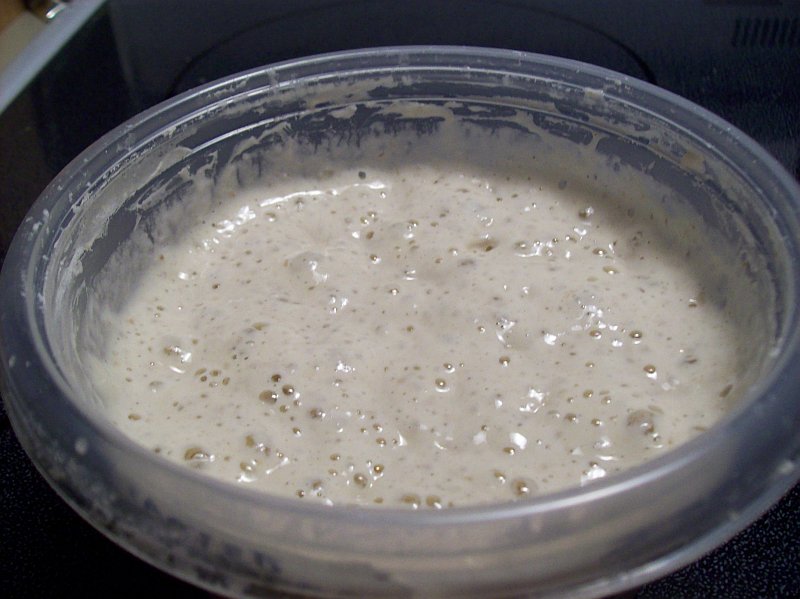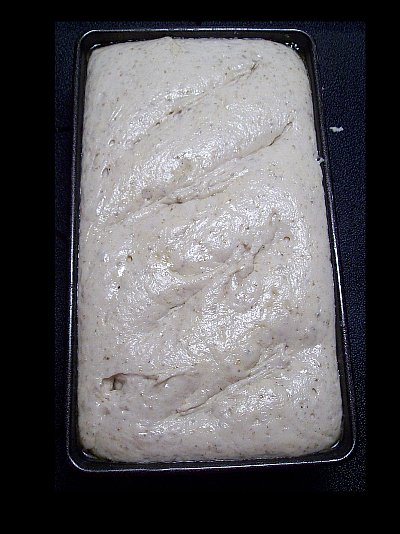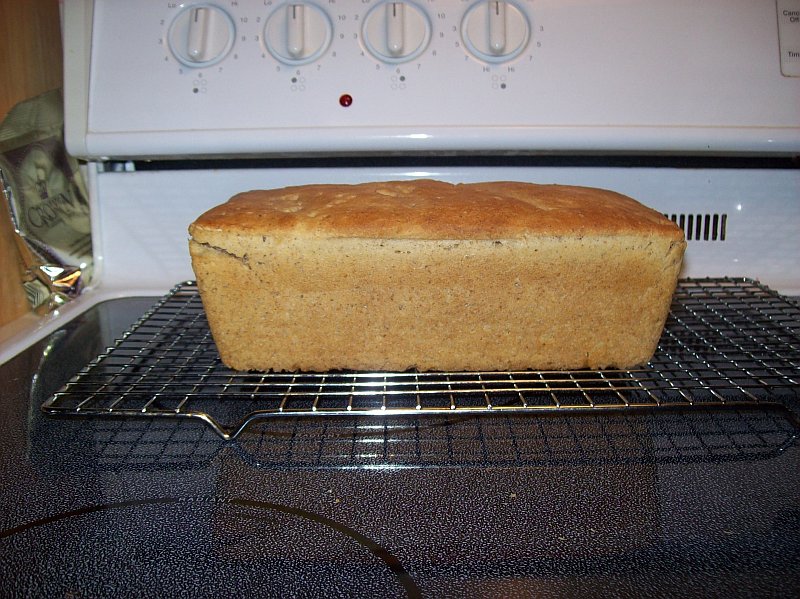Yesterday I started my recipe for a Sourdough. My starter has been aging for 5 months and is active, but not as sour as I would like. I used a cup of this starter before feeding. Sometimes I use a bit of WG Rye to keep the yeasties happy. And from time to time I'll add a teaspoon of pineapple juice to keep up the acidity.

My normal starter feed is 3/8 cup AP unbleached flour and 1/4 cup water. I leave it out till it doubles and then refrigerate. Yeast activity looks good.

My sponge is 1 cup starter, 2 cups AP flour, and 1 cup water. I let this restand after this has doubled to tripled, I make the dough. This consists of all the sponge, 1 1/4 cup AP flour, 1/4 cup WG Rye, 2 tsp. salt, 1 tsp. sugar, 1 tbsp. vital wheat gluten, and 2 tbsp. olive oil. I mixed and kneaded until my thumbprint stayed indented. I did this by mostly pulling and stretching the dough, but was never able to get the shiny surface I wanted. Was late so I put the dough in the fridge overnight. Next day, today, I took the dough and worked it some more trying to get it smooth. No luck and the dough would not stand up enough to meale a boule, so to the loaf pan it went. I let it proof until double and then baked.

Then I baked in a 425 degree oven for 15 minutes. Spraying water before preheat, spraying once I load the loaf, and final spray about 10 minutes later. Next I reduce the heat to 375 degress and baked another 20 minutes and finish with the oven off, door open for final 5 minutes.



The crumb is not as open as I would like and while it is sour, I would like it a little more so. I think the crumb is affected by the vital wheat gluten, but it is not dense or heavy feeling. Next step is repeatability.
I'm still confused why my dough would not hold shape. Even my slashes, with a razor blade, were hard to make due to the wettness of the dough.
Suggestions would be helpful.
A reasonable suggestion for you is change over from using volume measurements to using weight measurement of the ingredients. That will help you in maintaining the proper hydration, flour to water ratio, and to obtain consistent results. This simple step has made a big difference for many bakers. Use the search box in the upper left hand of the page and look up baker's percentages as a starting point.
As an alternative, read the tutorials that are listed on the home page. You can't go wrong by studying those lessons.
Hi dlstanf2,
Am I correct in saying that your dough recipe did not include any additional water, just flour / salt / sugar / oil added to the starter?
By my calculations your sponge had a hydration of about 85%, although it's hard to tell for sure since it depends on exactly how much the starter had increased in volume since it's feeding.
But your final dough had a hydration of only 54%, because no additional water was added.
From what I can tell, it doesn't sound like the recipe you're using is geared towards making the bread you want to make. Here is a good recipe for sourdough using a 100% starter*: http://www.wildyeastblog.com/2007/07/08/my-new-favorite-sourdough/ It was recommended to me as a good recipe for my first sourdough bake.
*Note your starter is ~100% hydration, since 3/8 cup flour and 1/4 cup water weigh approximately the same. (I would strongly recommend getting a digital kitchen scale though, it makes everything a lot easier and takes the guessing out. In fact see this thread I started when I was just beginning, hoping to find some advice on not using a scale, the best advice I got was "get a scale". However, until you get one, use 150g flour = 1 cup. And 1 cup water = 236g, or use the mL if your measures have them, because 1mL water = 1g)
You probably want a recipe that doesn't have added sugar (this will counteract the sourness). Also, I think part of the reason your dough was so hard to shape, was because of A) the high amount of sponge compared to final dough flour (this is sometimes called inoculation); and B) the fact that no additional water was added. Your sponge will have developed some acidity while it fermented, and in the presence of this acidity it is hard for the flour to develop its gluten.
To sum up, I'm still pretty much a beginner, but I've had some luck with recipes like the Norwich Sourdough one above.
Cheers and happy baking
Mike
Thanks Mike. All totaled there's 4 1/2 cups flour and 2 cups water to this recipe. And that's about a 75% hydration level. Even at this level my dough is wet feeling and has to be folded and stretched in the bowl. My 1/4 cup rye flour addition probably kept me from having the smooth elastic feel. I agree with the sugar tempering my sourness. I will have to try another recipe.
I'm trying to do this bread making by volume and feel. Others say use scales. I have scales, temperature probes, and all the "gadgets". I'm sure if there were ammunition reloaders on the site, they would be using grains of flour and water, instead of grams. I really appreciate the bakers, food scientist, and chemists, on TFL that have taken the time to research what happens and why in the bread making process.
I've got my flour and water measurements for my starter down to 1/8 cup, (my coffee spoon). 1/8 cup of flour weighs 17 grams and 1/8 cup of water equals 1 oz; 1 cup flour equals 136 grams, and 1 cup of water is 230 grams. This is how my filling, scooping, and fluffy technique works out using my equipment. Also, my starter hydration is about 90%. I would like to be about 50%, just to maintain, as I'm not making bread every week.
As I'm trying to reproduce 'old methods', where everything was done by volume, I prefer not to get weighted down by measurements. I believe I can make a descent loaf of bread with flour, water, oil, and maybe a little sweetener, like honey. I want a good solid recipe that I can reproduce regularly.
Now that I have a descent starter, I will keep trying different recipes, of the simple variety, until I get consistency. I'll photograph the results and post the pictures while I struggle through. This is a quest and I an avid reader of all the post here.
Once again, thanks for your input.
Don
That is a huge amount of starter! Wow, that looks like enough starter for a few loaves of bread from the looks of that sponge. Also, why do you need vital wheat gluten? I only use this on rare occassions when I'm substituting whole wheat flour for high gluten flour.
Most of my starter builds start with 15-25 grams of starter depending on the recipe. Also, your starter looks pretty wet, even for a 100% hydration. I have to wonder if the hydration is actually higher than you think.
Try measuring out a tablespoon of starter and then weigh out your flour and water, making a 60% and 100% starter build. Do this a couple of times so that you get the feel of it with your spoon, hands and the way it looks to your eyes.
You shouldn't need more than about 150 grams of starter/sponge. In my experience any more than that tends to break down glutens.
Also, I think if you start adding touches of whole wheat and rye flour you might find that you don't need any sugar either. The natural sugars of the bread really come alive when using starter. My 100% rye bread almost tastes like it has molasses in it and it only contains rye flour, water and salt.
Good job getting a nice lively sourdough starter! Very impressive.
Some things about sourdough are counter-intuitive, like getting a sour flavor from the actual end product. A longer ferment with less starter will make the final bread more sour. If I were you I would make a firm starter for my first build using something like 1/4 cup starter, 1 cup flour, 1/2 cup water (mass measurements are better...). Then finish the dough with the rest of the ingreidents and allow a longer rise.
Your starter itself can also get more sour if you give it larger feedings. The more water and flour you feed it at a time, the more you're favoring the bacteria that make it sour.
The most sour bread I've ever made was a mixed flour miche from Hamelman's Bread that started with a very small amount of starter, had a 14 hour build to the starter and then I accidently had to hold the bread overnight (it specifically said not to) in a cool setting (40deg).
I think less starter, firmer starter, more flour per feedings will help you get the taste you want. Starving starter isn't much good for anything. Increase your sour not by starving your starter but by taking care of it and changing your fermentation methods of the final dough and perhaps the ingredients in the starter plus the amount of feedings/temps of the starter builds. I never have hooch on my starter and it never smells like beer either. Starter should smell sweet and tangy, have an acidic, complex flavor but never taste bitter or acoholic. My dogs find it's the best thing going in a treat!
I've heard that using old bread to feed a starter results in a very sour bread as well. (not your mother starter, just the build)
I love making a simple 1/2/3 bread with a starter that was built up to 150 grams using 25 grams starter. I use 75% hydration so it's not a true 1/2/3 bread but I still call it that. Total flour is 450 grams. 2% salt. This is made with 100% whole wheat or whole wheat+rye/spelt so this is why I increase the water so much and make a bunch of stretch/folds. The build for the starter is fed once about 12 hours before using but is used at least once a week so pretty well fed.
I let this sit overnight to at least double on the countertop. Shape/bake in the morning.(8 hours later) This makes a very tangy bread, pleasantly sour but yet the sweetness of the flours come through without any added sugar or oil.
My rye is made with Mini's Fav Rye formula and it literally tastes like it has molasses in it. It's also fairly sour and yet has a smooth, complex flavor, like drinking a very fine red wine. I've yet to have someone taste it who hasn't said it's the very best rye bread they've ever tasted in their entire life!
My husband loves a very tangy sour bread so I'm always pushing the limit to increase sour. Believe me, once your starter is well going and can raise bread you need nothing but flour and water to maintain it. Get rid of the pineapple or any other additives. And, lose the vital wheat gluten, especially in normal white breads. Unless you know why you're putting something in there it probably doesn't need to be there.
Check out the thread "Squeezing more sour out of your starter" by JMonkey, at least I believe that is who posted and started the thread. Very informative.
Hamelman's Bread has a wonderful section on taking care of your starter and he also has the most detailed formulas as far as how to build your starter for each bread.
Isn't sourdough fascinating and fun?
I happen to have the summary to that posting on file. I also wanted to suggest that, since your loaf ran out of "ooomph" and didn't rise in the oven, it seems like yeast activity has flagged by the time you've got it in baking. Some rejigging of your method aimed at keeping those yeasties active will get you going in the right directions.
Here are the summary points to the post about making bread sour. I highly recommend reading through the post for more info:
1) Keep the starter stiff
2) Spike your white starter with whole rye
3) Use starter that is well-fed
4) Keep the dough cool
5) Extend the rise by degassing
6) Proof the shaped loaves overnight in the fridge
Hi
Here is a page I think will help. Look at all the links you need and study them.
Mike is a master baker . All I ever needed for sour dough bread. It is a bible to me
Mr. Bob
Here is the link http://www.sourdoughhome.com/recipes.html
Thanks for the suggestions. I'm trying KAF's Merlin's Magic Sourdough now. Before I was using the Sourdough Basics recipe. I've also tried Dourdough Lady's Deluxe Soughdough, but I didn't like all the added additions, too sweet.
I made Merlin's Magic Sourdough sponge this morning and I'm letting it ferment, or autolyse, as many call it, but it's supposed to induce that "sourness" we all look to find. I think I will make the dough later tonight, proof & then shape, and put the shaped loaf in the refridge overnight. I think I'll make this an oval loaf and bake it sometime tomorrow. Will post pics as well.
And, for those interested in weight measurements, I've recorded those. Figured I might as well try weights until I've mastered what my dough should feel like.
My starter is okay as the sponge has doubled. I used the starter straight from the fridge before feeding.